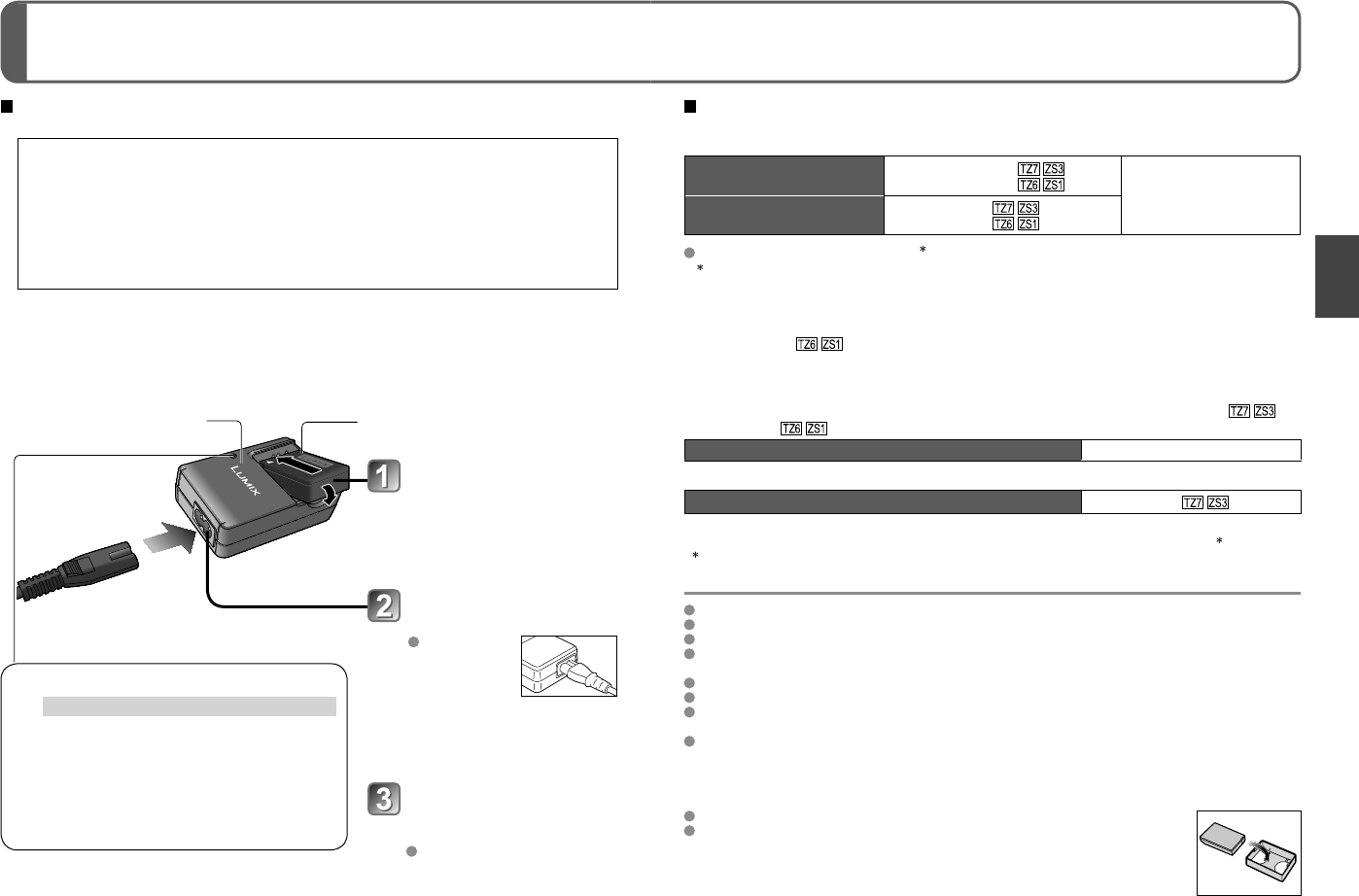
10 VQT1Z96 (ENG) (ENG) VQT1Z96 11
Charging battery
Always charge before first use! (not sold pre-charged)
About batteries that you can use with this unit (as of February 2009)
The battery that can be used with this unit is DMW-BCG10E.
It has been found that counterfeit battery packs which look very similar to the
genuine product are made available to purchase in some markets. Some of
these battery packs are not adequately protected with internal protection to
meet the requirements of appropriate safety standards. There is a possibility
that these battery packs may lead to fire or explosion. Please be advised that
we are not liable for any accident or failure occurring as a result of use of
a counterfeit battery pack. To ensure that safe products are used we would
recommend that a genuine Panasonic battery pack is used.
• Use the dedicated charger and battery.
•
This camera has a function identifying batteries that can be used, and this function is
compatible with the dedicated battery (DMW-BCG10E). (Batteries not compatible with
this function cannot be used.)
Battery (model-specific)
Charging light (CHARGE)
On:
Charging in progress, approx. 130 min. (Max.)
Off: Charging complete
If light is flashing:
• Charging may take longer than normal if
battery temperature is too high or too low
(charging may not be completed).
• Battery/charger connector is dirty. Clean with
a dry cloth.
Charger (model-specific)
Insert the battery
terminals and attach
the battery to the
charger
Ensure ‘LUMIX’ faces
outwards.
Connect the charger
to the electrical outlet
The AC
mains lead
does not fit
entirely into
the AC input terminal.
A gap will remain as shown
right.
Detach the battery
after charging is
complete
Disconnect charger and
battery when charging is
complete.
The battery life
Figures may be reduced if intervals between recordings are longer; if flash, zoom, or LCD
MODE are used frequently; or in colder climates (depends on actual usage).
Number of recordable
pictures
Approx. 300 pictures
Approx. 320 pictures
By CIPA standard in normal
picture mode
Recording time
Approx. 150 min
Approx. 160 min
Recording conditions by CIPA standard
CIPA is an abbreviation of [Camera & Imaging Products Association].
• Temperature 23 °C, humidity 50 %
• LCD monitor ON
(The number of recordable pictures decreases
in AUTO POWER LCD, POWER LCD, and
HIGH ANGLE
mode)
• Using Panasonic SD memory card (32 MB)
• Using the supplied battery
• NORMAL PICTURE mode
• First picture taken 30 sec. after power turned
on (STABILIZER ‘AUTO’)
• 1 picture taken per 30 sec.
• Full flash used for every other picture
• Zoom operation for each picture
(max. W → max. T, or max. T → max. W)
• Power turned off after each 10 pictures,
battery allowed to cool
Number reduced if intervals longer – e.g. to approx. one quarter (75 pictures /
80 pictures ) for 2-minute intervals under the above conditions.
Playback time Approx. 300 min
The number of recordable pictures or available recording time may vary slightly according to battery and usage conditions.
Recording time capacity (motion pictures)
Approx. 90 min
• Continuous recording with ‘REC MODE’ set to ‘AVCHD Lite’ and ‘REC QUALITY’ to ‘SH’
Available recording time varies according to usage conditions and intervals between recording.
Available recording time will be reduced when the camera is switched ‘ON’/‘OFF’, recording is
stopped/started, or zoom operations are used frequently.
Battery will be warm during charging and for some time thereafter.
Battery will run out if not used for long periods of time, even after being charged.
Charge the battery with the charger indoors (10 °C - 35 °C).
Frequently charging up battery is not recommended.
(Frequently charging battery reduces maximum usage time and can cause battery to expand.)
Do not disassemble or modify the charger.
If available battery power is significantly reduced, battery is reaching end of lifespan. Please purchase a new battery.
The battery charger is in the standby condition when the AC power supply cord is connected.
The primary circuit is always “live” as long as the power cord is connected to an electrical outlet.
When charging
• Remove any dirt on connectors of charger and battery with dry cloth.
• Keep at least 1 m away from AM radio (may cause radio interference).
• Noises may be emitted from inside of charger, but this is not a fault.
•
Always remove from mains socket after charging (up to 0.1 W consumed if left in place).
Store battery in battery carrying case after use.
Do not use if damaged or dented (especially connectors), e.g. by dropping (can
cause faults).


















